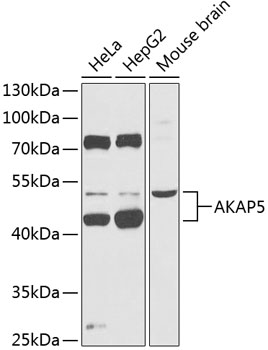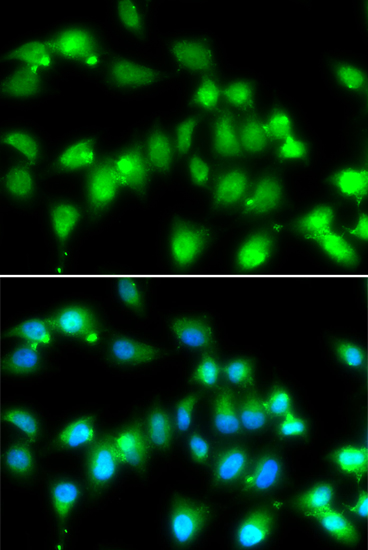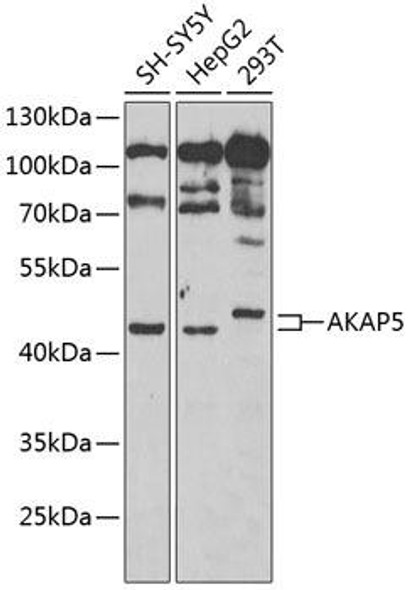Cell Biology Antibodies 4
Anti-AKAP5 Antibody (CAB14091)
- SKU:
- CAB14091
- Product Type:
- Antibody
- Reactivity:
- Human
- Reactivity:
- Mouse
- Host Species:
- Rabbit
- Isotype:
- IgG
- Antibody Type:
- Polyclonal Antibody
- Research Area:
- Cell Biology
Description
| Antibody Name: | Anti-AKAP5 Antibody |
| Antibody SKU: | CAB14091 |
| Antibody Size: | 20uL, 50uL, 100uL |
| Application: | WB IF |
| Reactivity: | Human, Mouse |
| Host Species: | Rabbit |
| Immunogen: | Recombinant fusion protein containing a sequence corresponding to amino acids 1-270 of human AKAP5 (NP_004848.3). |
| Application: | WB IF |
| Recommended Dilution: | WB 1:500 - 1:2000 IF 1:50 - 1:200 |
| Reactivity: | Human, Mouse |
| Positive Samples: | HeLa, HepG2, Mouse brain |
| Immunogen: | Recombinant fusion protein containing a sequence corresponding to amino acids 1-270 of human AKAP5 (NP_004848.3). |
| Purification Method: | Affinity purification |
| Storage Buffer: | Store at -20'C. Avoid freeze / thaw cycles. Buffer: PBS with 0.02% sodium azide, 50% glycerol, pH7.3. |
| Isotype: | IgG |
| Sequence: | METT ISEI HVEN KDEK RSAE GSPG AERQ KEKA SMLC FKRR KKAA KALK PKAG SEAA DVAR KCPQ EAGA SDQP EPTR GAWA SLKR LVTR RKRS ESSK QQKP LEGE MQPA INAE DADL SKKK AKSR LKIP CIKF PRGP KRSN HSKI IEDS DCSI KVQE EAEI LDIQ TQTP LNDQ ATKA KSTQ DLSE GISR KDGD EVCE SNVS NSTT SGEK VISV ELGL DNGH SAIQ TGTL ILEE IETI KEKQ DVQP QQAS PLET SETD HQQP VLSD VPPL PA |
| Gene ID: | 9495 |
| Uniprot: | P24588 |
| Cellular Location: | Lipid-anchor, Membrane |
| Calculated MW: | 47kDa |
| Observed MW: | 47kDa |
| Synonyms: | AKAP5, AKAP75, AKAP79, H21 |
| Background: | The A-kinase anchor proteins (AKAPs) are a group of structurally diverse proteins, which have the common function of binding to the regulatory subunit of protein kinase A (PKA) and confining the holoenzyme to discrete locations within the cell. This gene encodes a member of the AKAP family. The encoded protein binds to the RII-beta regulatory subunit of PKA, and also to protein kinase C and the phosphatase calcineurin. It is predominantly expressed in cerebral cortex and may anchor the PKA protein at postsynaptic densities (PSD) and be involved in the regulation of postsynaptic events. It is also expressed in T lymphocytes and may function to inhibit interleukin-2 transcription by disrupting calcineurin-dependent dephosphorylation of NFAT. |
| UniProt Protein Function: | AKAP5: May anchor the PKA protein to cytoskeletal and/or organelle-associated proteins, targeting the signal carried by cAMP to specific intracellular effectors. Association with to the beta2-adrenergic receptor (beta2-AR) not only regulates beta2-AR signaling pathway, but also the activation by PKA by switching off the beta2-AR signaling cascade. Binding protein for dimer of the RII-beta regulatory subunit of cAMP-dependent protein kinase (PKA) and also for the protein kinase C (PKC) and the phosphatase calcineurin (PP2B). Each enzyme is inhibited when bound to the anchoring protein. Also binds the beta2-adrenergic receptor. Part of a complex containing AKAP5, ADCY5, ADCY6 AND PDE4C. Interacts with ADCY8, and enhances its phosphorylation at lipid rafts. Predominantly in the cerebral cortex and the postsynaptic densities of the forebrain, and to a lesser extent in adrenal medulla, lung and anterior pituitary. |
| UniProt Protein Details: | Protein type:Adaptor/scaffold Chromosomal Location of Human Ortholog: 14q23.3 Cellular Component: cytosol; plasma membrane Molecular Function:adenylate cyclase binding; protein binding; protein kinase A binding Biological Process: positive regulation of cAMP biosynthetic process; synaptic transmission |
| NCBI Summary: | The A-kinase anchor proteins (AKAPs) are a group of structurally diverse proteins, which have the common function of binding to the regulatory subunit of protein kinase A (PKA) and confining the holoenzyme to discrete locations within the cell. This gene encodes a member of the AKAP family. The encoded protein binds to the RII-beta regulatory subunit of PKA, and also to protein kinase C and the phosphatase calcineurin. It is predominantly expressed in cerebral cortex and may anchor the PKA protein at postsynaptic densities (PSD) and be involved in the regulation of postsynaptic events. It is also expressed in T lymphocytes and may function to inhibit interleukin-2 transcription by disrupting calcineurin-dependent dephosphorylation of NFAT. [provided by RefSeq, Jul 2008] |
| UniProt Code: | P24588 |
| NCBI GenInfo Identifier: | 281185503 |
| NCBI Gene ID: | 9495 |
| NCBI Accession: | P24588.3 |
| UniProt Secondary Accession: | P24588,A2RRB8, |
| UniProt Related Accession: | P24588 |
| Molecular Weight: | 47,088 Da |
| NCBI Full Name: | A-kinase anchor protein 5 |
| NCBI Synonym Full Names: | A-kinase anchoring protein 5 |
| NCBI Official Symbol: | AKAP5 |
| NCBI Official Synonym Symbols: | H21; AKAP75; AKAP79 |
| NCBI Protein Information: | A-kinase anchor protein 5 |
| UniProt Protein Name: | A-kinase anchor protein 5 |
| UniProt Synonym Protein Names: | A-kinase anchor protein 79 kDa; AKAP 79; H21; cAMP-dependent protein kinase regulatory subunit II high affinity-binding protein |
| Protein Family: | A-kinase anchor protein |
| UniProt Gene Name: | AKAP5 |
| UniProt Entry Name: | AKAP5_HUMAN |
View AllClose








